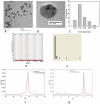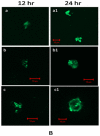Aloe vera induced biomimetic assemblage of nucleobase into nanosized particles
- PMID: 22403622
- PMCID: PMC3293877
- DOI: 10.1371/journal.pone.0032049
Aloe vera induced biomimetic assemblage of nucleobase into nanosized particles
Abstract
Aim: Biomimetic nano-assembly formation offers a convenient and bio friendly approach to fabricate complex structures from simple components with sub-nanometer precision. Recently, biomimetic (employing microorganism/plants) synthesis of metal and inorganic materials nano-particles has emerged as a simple and viable strategy. In the present study, we have extended biological synthesis of nano-particles to organic molecules, namely the anticancer agent 5-fluorouracil (5-FU), using Aloe vera leaf extract.
Methodology: The 5-FU nano- particles synthesized by using Aloe vera leaf extract were characterized by UV, FT-IR and fluorescence spectroscopic techniques. The size and shape of the synthesized nanoparticles were determined by TEM, while crystalline nature of 5-FU particles was established by X-ray diffraction study. The cytotoxic effects of 5-FU nanoparticles were assessed against HT-29 and Caco-2 (human adenocarcinoma colorectal) cell lines.
Results: Transmission electron microscopy and atomic force microscopic techniques confirmed nano-size of the synthesized particles. Importantly, the nano-assembled 5-FU retained its anticancer action against various cancerous cell lines.
Conclusion: In the present study, we have explored the potential of biomimetic synthesis of nanoparticles employing organic molecules with the hope that such developments will be helpful to introduce novel nano-particle formulations that will not only be more effective but would also be devoid of nano-particle associated putative toxicity constraints.
Conflict of interest statement
Figures









Similar articles
-
Biomimetically engineered Amphotericin B nano-aggregates circumvent toxicity constraints and treat systemic fungal infection in experimental animals.Sci Rep. 2017 Sep 19;7(1):11873. doi: 10.1038/s41598-017-11847-0. Sci Rep. 2017. PMID: 28928478 Free PMC article.
-
Synthesis of gold nanotriangles and silver nanoparticles using Aloe vera plant extract.Biotechnol Prog. 2006 Mar-Apr;22(2):577-83. doi: 10.1021/bp0501423. Biotechnol Prog. 2006. PMID: 16599579
-
Aloe barbadensis Miller mediated green synthesis of mono-disperse copper oxide nanoparticles: optical properties.Spectrochim Acta A Mol Biomol Spectrosc. 2012 Nov;97:1140-4. doi: 10.1016/j.saa.2012.07.096. Epub 2012 Aug 8. Spectrochim Acta A Mol Biomol Spectrosc. 2012. PMID: 22940049
-
Antitumor properties and modulation of antioxidant enzymes' activity by Aloe vera leaf active principles isolated via supercritical carbon dioxide extraction.Curr Med Chem. 2010;17(2):129-38. doi: 10.2174/092986710790112620. Curr Med Chem. 2010. PMID: 19941474 Review.
-
Final report on the safety assessment of AloeAndongensis Extract, Aloe Andongensis Leaf Juice,aloe Arborescens Leaf Extract, Aloe Arborescens Leaf Juice, Aloe Arborescens Leaf Protoplasts, Aloe Barbadensis Flower Extract, Aloe Barbadensis Leaf, Aloe Barbadensis Leaf Extract, Aloe Barbadensis Leaf Juice,aloe Barbadensis Leaf Polysaccharides, Aloe Barbadensis Leaf Water, Aloe Ferox Leaf Extract, Aloe Ferox Leaf Juice, and Aloe Ferox Leaf Juice Extract.Int J Toxicol. 2007;26 Suppl 2:1-50. doi: 10.1080/10915810701351186. Int J Toxicol. 2007. PMID: 17613130 Review.
Cited by
-
Bio-mediated synthesis of 5-FU based nanoparticles employing orange fruit juice: a novel drug delivery system to treat skin fibrosarcoma in model animals.Sci Rep. 2019 Aug 23;9(1):12288. doi: 10.1038/s41598-019-48180-7. Sci Rep. 2019. PMID: 31444363 Free PMC article.
-
miR-451a Inhibited Cell Proliferation and Enhanced Tamoxifen Sensitive in Breast Cancer via Macrophage Migration Inhibitory Factor.Biomed Res Int. 2015;2015:207684. doi: 10.1155/2015/207684. Epub 2015 Jun 16. Biomed Res Int. 2015. Retraction in: Biomed Res Int. 2022 Jul 1;2022:9758629. doi: 10.1155/2022/9758629. PMID: 26161389 Free PMC article. Retracted.
-
A comparative ex vivo permeation evaluation of a novel 5-Fluorocuracil nanoemulsion-gel by topically applied in the different excised rat, goat, and cow skin.Saudi J Biol Sci. 2020 Apr;27(4):1024-1040. doi: 10.1016/j.sjbs.2020.02.014. Epub 2020 Mar 3. Saudi J Biol Sci. 2020. PMID: 32256163 Free PMC article.
-
Gold Nanoparticle-Photosensitizer Conjugate Based Photodynamic Inactivation of Biofilm Producing Cells: Potential for Treatment of C. albicans Infection in BALB/c Mice.PLoS One. 2015 Jul 6;10(7):e0131684. doi: 10.1371/journal.pone.0131684. eCollection 2015. PLoS One. 2015. PMID: 26148012 Free PMC article.
-
Biomimetically engineered Amphotericin B nano-aggregates circumvent toxicity constraints and treat systemic fungal infection in experimental animals.Sci Rep. 2017 Sep 19;7(1):11873. doi: 10.1038/s41598-017-11847-0. Sci Rep. 2017. PMID: 28928478 Free PMC article.
References
-
- Roco MC. Nanotechnology: convergence with modern biology and medicine. Curr Opin Biotechnol. 2003;14:337–343. - PubMed
-
- Gupta RB, Kompella Nanoparticle Technology for Drug Delivery. 2006. pp. 1–379. Taylor & Francis Group, New York, U.B. Eds.
-
- Wilkinson JM. Nanotechnology applications in medicine. Med Device Technol. 2003;14:29–31. - PubMed
-
- Schimidt J, Montemagno C. Using machines in cells Drug Discov. Today. 2002;7:500–503. - PubMed
-
- Lobenberg R, Kreuter J. Macrophage targeting of azidothymidine: a promising strategy for AIDS therapy. AIDS Res Hum Retroviruses. 1996;12:1709–1715. - PubMed
Publication types
MeSH terms
Substances
LinkOut - more resources
Full Text Sources

